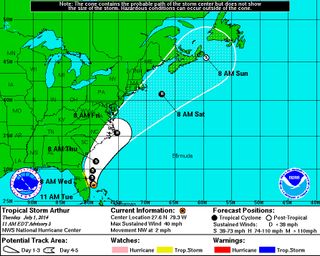Tropical Storm Arthur Kicks Off Atlantic Hurricane Season

The first tropical storm of the Atlantic hurricane season has finally formed, and it's likely to foul Fourth of July festivities for some East Coast residents this weekend.
The National Hurricane Center declared the formation of Tropical Storm Arthur this morning (July 1). Arthur is the first named storm of the 2014 Atlantic hurricane season.
A tropical storm watch has been issued for the east coast of Florida, and residents there should expect heavy rain on Tuesday and Wednesday, according to the National Hurricane Center storm forecast.
Arthur is expected to strengthen into a category one hurricane by 2 a.m. ET on Friday, July 4, as it briefly makes landfall on North Carolina's Outer Banks. A category one hurricane has winds stronger than 74 mph (119 km/h).
However, the "cone of uncertainty" in the storm's future track means Arthur could brush over the Carolina coast or stay offshore on Friday.

The storm could also rake the Mid-Atlantic coast with strong winds and rain this weekend.
The 2014 Atlantic hurricane season forecast issued in May called for fewer storms than average, with a total of eight to 13 named storms, which include tropical storms (when winds reach 39 to 73 mph, or 62 to 117 km/h) and hurricanes. Between three and six of those storms are likely to become hurricanes, according to forecasters with the National Oceanic and Atmospheric Administration.
Sign up for the Live Science daily newsletter now
Get the world’s most fascinating discoveries delivered straight to your inbox.
The Atlantic hurricane season runs from June 1 through Nov. 30.
Email Becky Oskin or follow her @beckyoskin. Follow us @livescience, Facebook & Google+. Original article on Live Science.

